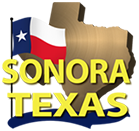The history of agriculture in Sutton County began in the early 1870s when ranchers moved into the area. Initially attracted by the availability of water in various places along the Devil's River, ranchers were drawn by the rich, unoccupied pastureland of the western Edwards Plateau. So successful were the herds that grazed the area that by 1878 the region was known as Stockman's Paradise, since both sheep and cattle ranching were important.
With the tremendous growth of the cattle industry in the late 1870s and early 1880s, the available rangeland across Texas was occupied quickly and in time fenced off into ranches. This trend was reflected in Sutton County but was slowed by the lack of accessible water. In 1882, the Birtrong Ranch, which depended on Wall's Well, was the area's only ranch. By 1885 there were eleven, all but one located near the region's few sources of water. That one exception was the ranch of A. J. Winkler, who in 1884 had drilled a well, successfully tapping the water table. Henceforth, ranching on the Edwards Plateau was closely tied to well water, its extraction made easier by the development of the wind-powered water pump and the horse-powered drill.
Increasing numbers of ranchers moved to the area and, in order to protect their water supplies and range grass from roaming herds, began to fence off their holdings. By 1898, scarcely ten years after the erection of the first fence, almost all of the area's 120 ranches were fenced. The discovery of a reliable water supply also stimulated settlement. Today's water is still protected, researched and monitored by the Sutton County Underground Water District.
The 1890s were a period of rapid growth for Sutton County. Sonora established itself as the principal marketing and social center. The greater availability of water and the low price of land stimulated the growth. In 1900, for example, state school land sold for a dollar an acre, roughly the price of eight pounds of wool. Land purchases were made even more feasible by the introduction of 3 percent forty-year loans. Consequently, large ranchers were able to purchase virtually all of Sutton County's lands.
As holdings grew larger, so also did herds. In Sutton County, unlike much of the Texas plains, sheep and later goat ranching dominated the local livestock industry. To some extent the increasing dominance of sheep herding resulted from the introduction of mechanical shearing in 1901. Goat raising owed its dramatic growth to the importation of the Angora variety in the early 1900s. This stimulated the development of a local mohair industry, which, combined with the wool harvest, established Sutton County as an important center in the production of animal fibers. In 1916, the Thirty-fourth Texas Legislature, in association with Texas A&M University, established an experimental station, dedicated to researching livestock diseases and methods of improving production, on five sections of land in the central part of the county. The Texas A&M Agriculture Experiment Station continues to provide a valuable service to ranchers in Sutton County and across the state.
Cattle continue to be a valuable livestock commodity in Sutton County. Many breeds graze the surrounding grassland including, but not limited to, Black Angus, Hereford, Brahma and Charolais. Many cattleraisers engage, with great success, in the crossbreeding of cattle. It is not unusual to see, for example, a Brahma or Angus bull grazing among a herd of Hereford cows. Crossbreeding has been used to develop sturdier livestock and better beef and is an important economic tool for the cattle ranchers today. There are many active members of the Texas Southwestern Cattleraisers Association in the County who bring a wealth of knowledge, information and activism to the industry.
Sheep remain a staple in the livestock economy. Sonora Wool & Mohair Company, established in 1929, continues to serve the marketing needs for wool and mohair distribution around the world. The Texas Sheep and Goat Raisers Association is a strong advocate for sheep and goat ranchers in the area.
Angora, Boer and Spanish goats are seen in great numbers throughout the county. The animal is well adapted to both the climate and the rangeland. The American Angora Goat Breeders Association is located in Rocksprings, Texas, just a few miles south of Sutton County, and was established in 1900 primarily to keep the records for American angora goat breeders. The American Meat Goat Association is headquartered right here in Sonora and continues to provide information and news to the industry. The American Boer Goat Association, located in San Angelo, TX is an active and vital organization for goat owners around the world.
Other organizations in Sutton County educate ranchers and our youth regarding all aspects of the agriculture industry. The Sutton County Extension Office is a vital source of education and information and 4-H is a community of young people across America who are learning leadership, citizenship, and life skills. Texas 4-H is open to all youth between the ages of 9 to 18.
